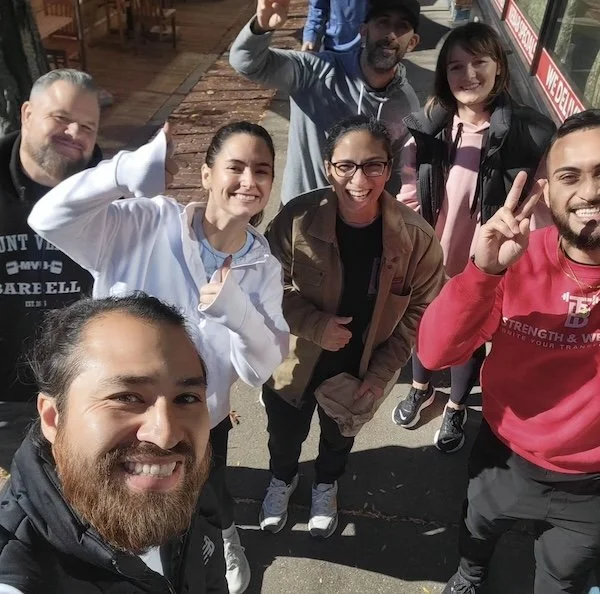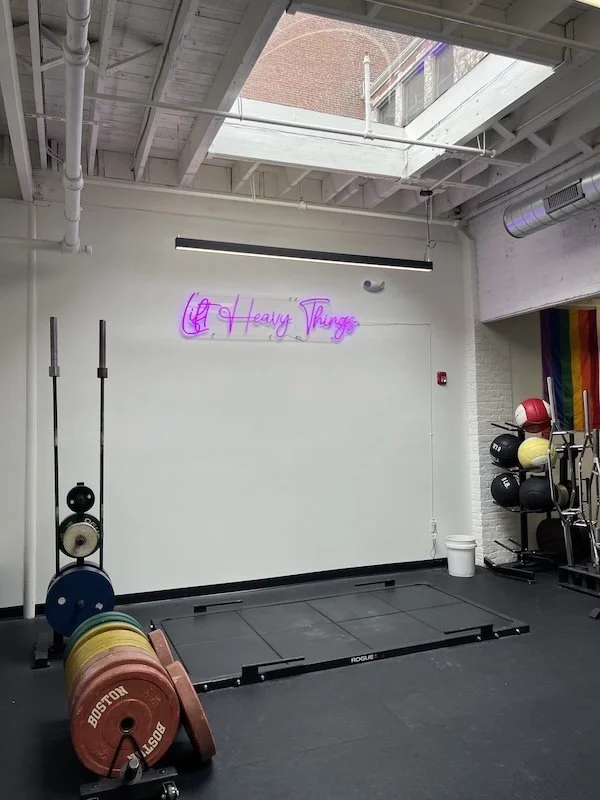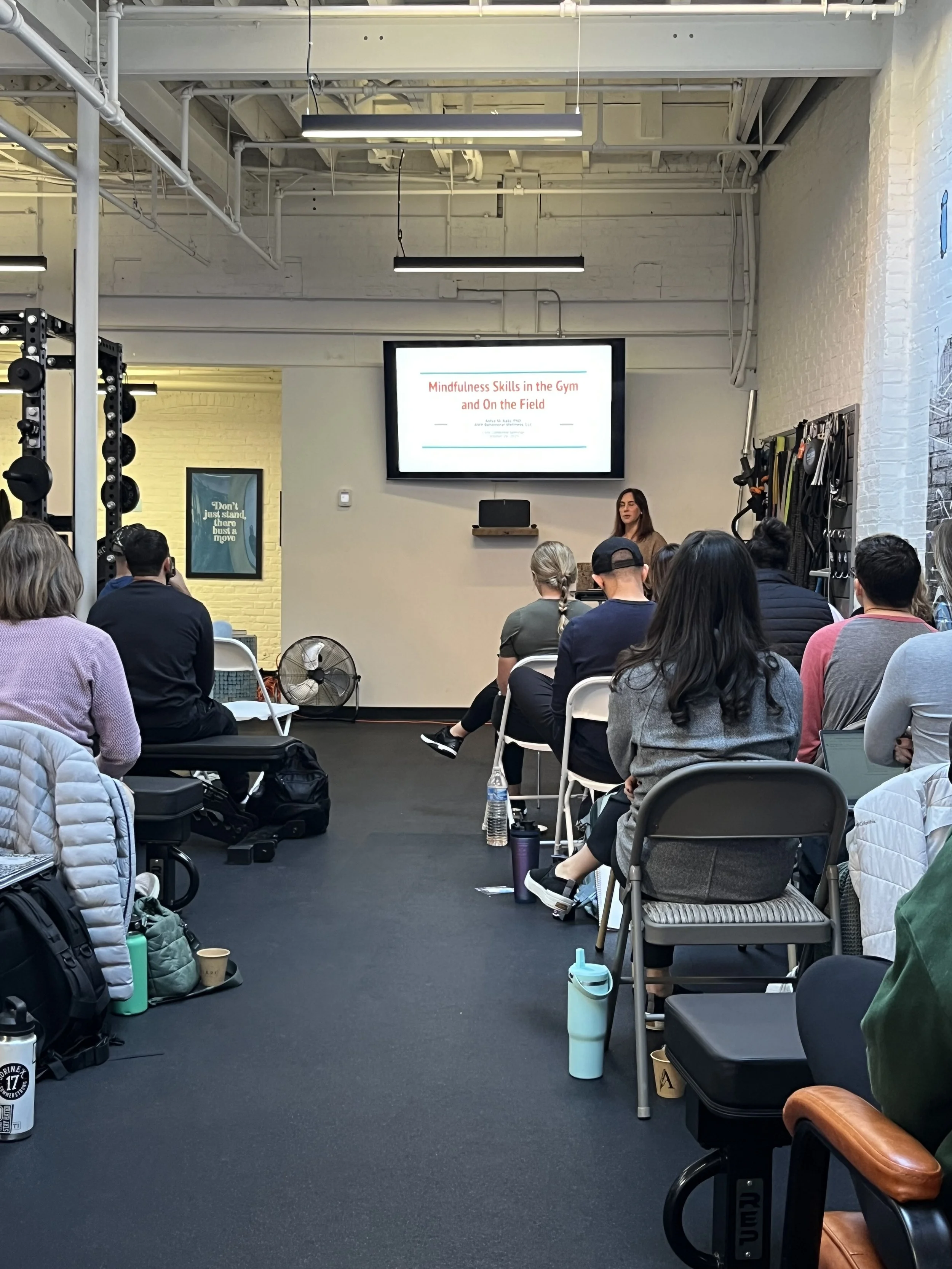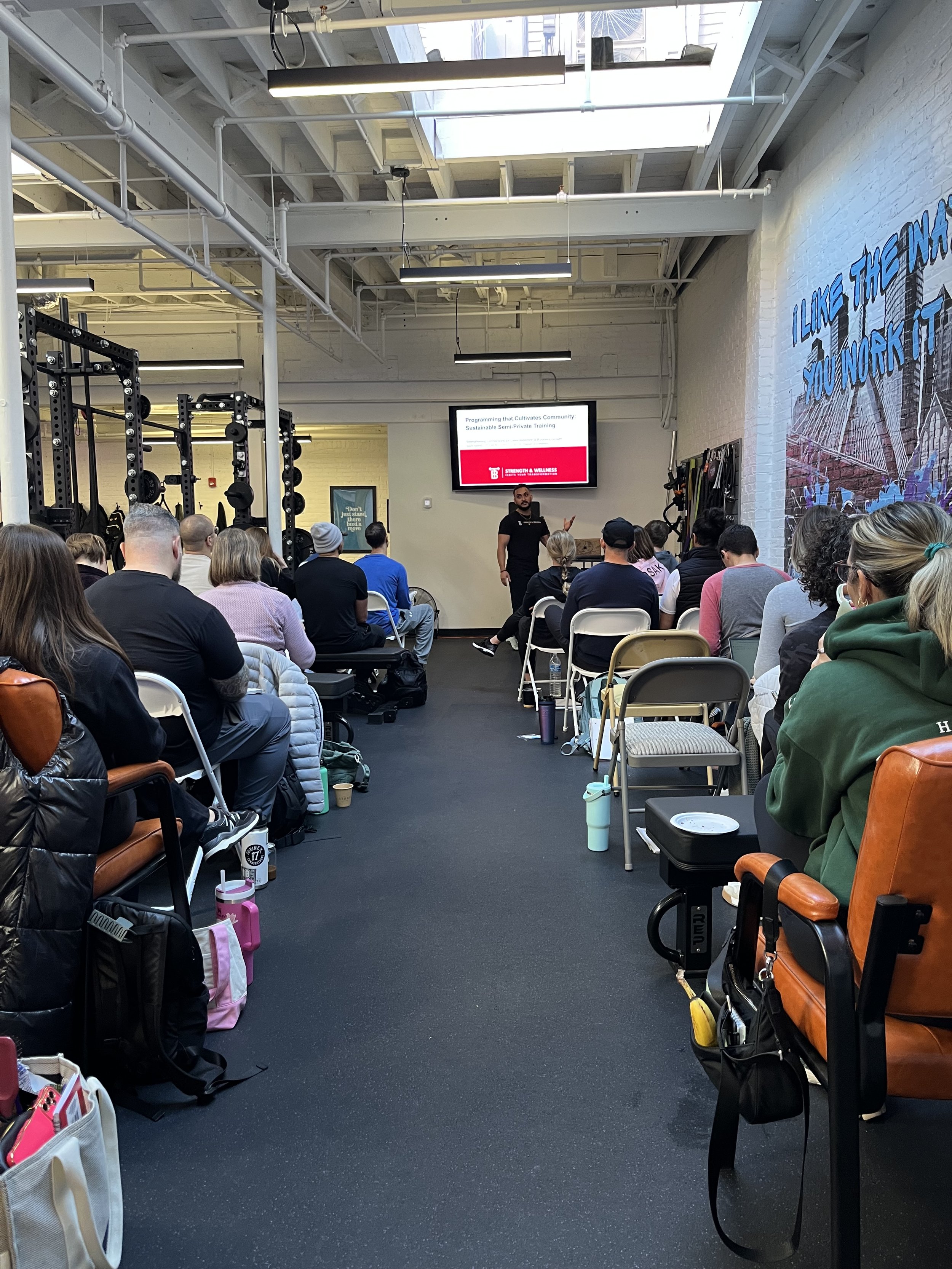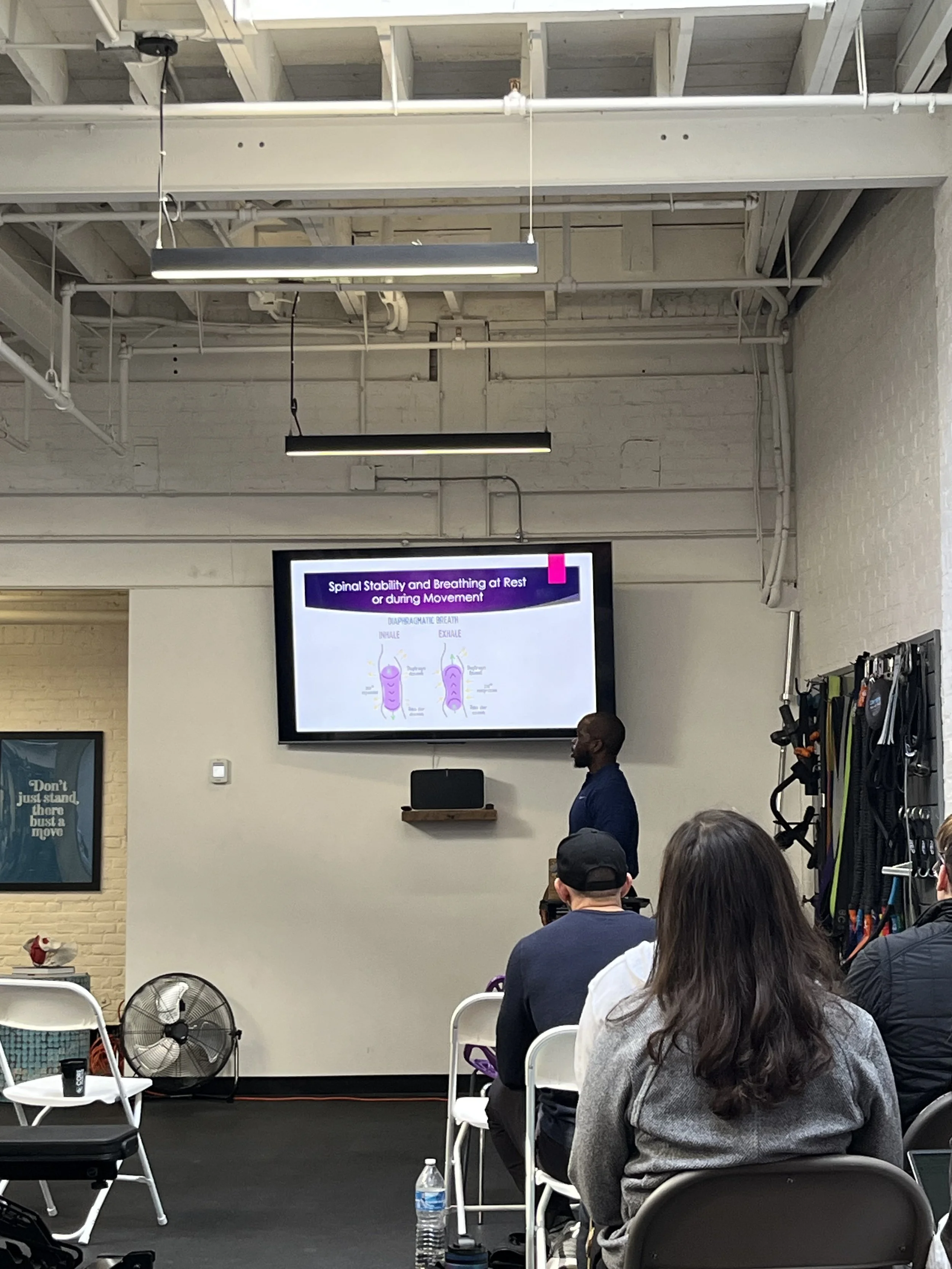Core Collective Seminar Recap (Fall 2025)
This past weekend I attended Core Collective’s first seminar, Building the Complete Client, in Brookline, Massachusetts. It was an awesome event filled with a group of friendly, encouraging, and growth-minded trainers who had some great insights to share.
Photo credit: Jon Camacho
In case you missed the seminar, here is a writeup of a few takeaways I learned this weekend. If you’re interested in learning more from any of these practitioners, please reach out to them!
Day 1:
Building a strong body and strong mind: the core collective model (presented by Tony Gentilcore)
Chase your dreams with tenacity.
Tony and Lisa, the founders and owners of Core Collective, dreamed of having a space where practitioners could collaborate, communicate, and build their own businesses under the same roof. Their space is incredible and has everything you could ask for, including a staff full of coaches, mental health professionals, dietitians, and physical therapists. They’ve created a space where people can be both friends and colleagues who can refer clients to one another, trade ideas, and collaborate with each other.
Say yes (even when you really want to say no), and above all else, be consistent.
I’ve followed Tony through his blog, articles, and YouTube videos for many years now. He has a huge library of information he’s amassed by consistently writing, speaking, and sharing his knowledge and experiences. We learned about he grew his personal brand from the ground up, which included saying yes to opportunities, and doing so often.
Using time under tension to build physical and mental strength (presented by Dr. Lisa Lewis)
Define your core values.
One of the first things I learned this weekend was Core Collective’s values. They are: autonomy, competence, and relatedness. Of course it sounds great to be able to mention a few words and say that you’re x,y,z, but do they really reflect what you do and believe? After spending a weekend in the Core home, it’s clear that this is in fact the heartbeat of their space.
Burnout is real but can be avoided.
What causes burnout? A heavy workload, too many hours, an unmanageable schedule, and/or challenging emotional demands can lead to being absolutely cooked. But how can it be dealt with? As Dr. Lewis explains, strong social and emotional support, balance, continuing education, and mental toughness can all create a buffer to offset the demands that we and others place on ourselves. Having some kind of supervision or connection to talk through issues you’re having, to celebrate wins and losses, and to just simply touch base can also help alleviate some of the pains and pressures that come with an emotionally demanding job.
Give people space to grow.
We know that people do not generally thrive in overly-controlled environments or in isolation. Humans need support and community, as well as the option to find their way, especially if they’re entrepreneurial by nature. What people need is “scaffolding” to shape themselves, not a mold to fit into.
Day 2- Full speaker panel
Dan Negron: “Staying in your lane” and coaching your best
Your lane as a coach is wider than you think.
While you of course don’t have the expertise to diagnose or prescribe rehab exercises, you do have the option to collaborate with any of their other practitioners. Doing so will give you a better sense of their treatment plan and any additional pieces to the puzzle you may not be able to see. As Dan mentions, oversharing in these instances is a good thing! After all, telling someone that your client has “lower back pain” isn’t particularly helpful but saying that they complain about back pain on the right side after they’ve traveled and done some squatting obviously gives a bit more context. In other words, be specific when possible!
Be curious and try to see the whole person.
Dan presented two case studies of clients with very similar symptoms and presentations. But after asking more “why’s" and probing a bit deeper into the full picture of their lives (after all, people are more than their pain), it was clear that these people needed different approaches despite their initial similarities. This sums up what coaching really is. Most people’s programs will probably look pretty similar, but the way in which you interact with and coach them will likely look quite different.
Cristine Seitz: Nutrition Hacks and habits
Protein and fiber are the newest “power couple” of fullness.
Yes, everyone now knows the magic of protein, but do they know that fiber is the other half of the picture when it comes to fullness? One of the benefits of eating protein is that it helps us with satiety, or fullness. But so does fiber. So when you pair these two nutrients, it helps keep you fuller longer and also aids digestion.
Frequent snacking may be due to inadequate meals.
Do you find yourself snacking, sometimes even after you just ate? This may be because you’re not eating enough at meal times or perhaps your meal wasn’t quite what you needed. If so, your body is smart and will try to get what it needs one way or another, like from more frequent snacks.
Nausea from GLP-1s may be due to dehydration.
If you or your client is taking GLP-1s (weight loss medications), they may report that they’re unable to eat a proper meal due to nausea. Sometimes this nausea comes from dehydration. You may want to suggest that they increase their fluid intake before taking their regular dose to help offset this side effect.
Aviva M. Katz: Mindfulness skills in the gym and on the field
If you notice your mind wandering, this doesn’t mean you’re “bad” at being mindful.
It just means you’re human. But also, if you can notice this, you are in fact being mindful. (I know this was a nice reframe for me!)
Mindfulness is a mindset.
Meaning that whatever comes up for you while sitting with yourself can be tolerated. No, we may not enjoy or like whatever this is, but we can tolerate it.
Give people choices and agency in their training.
While it is our job to coach people, it’s not our job to command them. A good coach is someone who teaches people to make decisions for themselves, and one way to do this is to provide options.
Issam Hatahet: Programming that cultivates community: Sustainable semi-private training
Community = marketing, retention, and well-being.
A happy community is its own form of marketing. If someone likes training with you, chances are they’ll probably mention it to a friend, and that friend may very well come to you for help. Happy clients are also more likely to stay engaged with their training which increases retention. And happy clients make their coach’s life easier and, well, also happier. Community is more than you as a coach. It’s about connecting the people in front of you and encouraging bonds between them. Teach people to lean on each other—not just you.
Show, don’t tell.
As coaches, we can often get lazy. We may stop demonstrating movements and just explain what we want someone to do rather than getting down on the floor and showing them. But a demonstration can be one of the most powerful ways to communicate something to a client—particularly intent in their movement. Have you ever demonstrated a “lazy” squat? People mimic us more than we realize, so let’s use that to our advantage.
Bring your energy.
While this wasn’t a talking point of Issam’s presentation, it was an action point. He moved, gestured, demonstrated, and spoke with an infectious energy and enthusiasm for his entire presentation. One of the most important parts of coaching is being able to command a room. Doing this well does not mean yelling, cursing—or just being an a**hole. In fact, the times when coaches can command the room most is through their energy and enthusiasm, which Issam was able to show, not tell (see above point).
Ben Getman: Training clients with anxiety
Exposure therapy can also be used in the training setting, not just a clinical one.
Many people think of using exposure therapy to overcome things like a fear of flying, spiders, etc., but it can also be used for training-related anxiety. Whether someone is returning from an injury, has social anxiety that interferes with their training, or is overwhelmed by gyms, exposing clients to increasingly tolerable stressors related to their fears and anxieties can help them overcome them.
When in doubt, provide more structure and collaboration when working with anxious clients.
Structure, consistency, and a safe and collaborative environment helps clients know what to expect, putting them in a better position to manage their anxiety. Try to normalize their discomfort (rather than over-assuring them) can help them become more resilient and comfortable over time.
Obinna Ndugba: How nutritional skills translate to weight loss
Use bigger movements for “bigger” caloric/energy expenditure.
When trying to increase the energy expenditure of a client, particularly for those with weight loss goals, use “bigger” or compound movements to do so. Compound movements allow us to use larger (and multiple) muscle groups at the same time, as opposed to isolation exercises which focus on singular and smaller muscles.
Train the appropriate energy system.
If the goal is weight loss, you’ll need to train the appropriate energy systems. Generally, you’ll want clients to be able to work at a pace and intensity that they can sustain for longer periods of time and at low to moderate intensity.
Lisa Lewis: Elaborating on the Transtheoretical Model of behavior change
Meet clients "where they’re at” through the lens of the transtheoretical model of change.
Meeting clients “where they’re at” means matching their degree of readiness. Understanding the transtheoretical model of change allows you to see which stage clients are in, and how to meet them appropriately. Coaches are always eager to help, but sometimes clients aren’t ready for this. Understanding how to recognize where people are at allows us to determine what help they need at this point in time.
You can’t drive a car with no gas in the tank.
As Dr. Lewis described, where clients fall in this model can be represented by how much gas is in their tank. If they’re in the later stages, they have a pretty full tank and may be more amenable to additional changes and challenges. But when someone is running on empty in earlier stages, it’s important to recognize this so you don’t overwhelm them with something they’re not ready for.
Jarrod Dyke: Coaching and strengthening youth in sports
“Youth athletes don’t care how much you know until they know how much you care.”
This was a direct quote from Jarrod and I think sums up the youth-coach dynamic perfectly. They want to know that they can trust and count on you to have their backs over anything else. You have to earn their trust by showing up for them when it matters and be their advocate.
You must be direct—but not an a**hole.
While being direct does not give you license to say whatever you want, it does mean to say what you mean and especially with young people, do so succinctly. Less is more. They have a limited attention span and are often easily distracted. They also don’t have the ability to read between the lines in the way that adults do. So you need to give it to them straight, but with care for the person in front of you.
Miriam Taha: Bump to baby: exercise prescription in the perinatal continuum
What are the pelvic floor muscles?
Many people don’t know what the elusive pelvic floor is or what it does, and often times we only think of women having a pelvic floor issues (which is false). The pelvic floor is a group of muscles that line the base of the pelvis. These muscles help to control your bladder and bowels, and stabilize the pelvis and surrounding muscles.
Pay attention to pelvic pain and blood pressure during pregnancy.
Clients may complain about hip and/or pelvic pain during pregnancy, which you’ll want to work around. Doing things like adjusting to bilateral (instead of unilateral) movements is a simple modification to help with this. You’ll also want to either mention to your clients to pay attention to their blood pressure, especially before training. High blood pressure can be a symptom of preeclampsia, so we definitely want to keep an eye on this before a workout.
Tony Gentilcore: Finding your clients’ trainable menu
Using the “trainable menu” is a great way to reframe training through injuries. Clients are often anxious about training with an injury or may assume complete rest is the best option. While this is the case at times (e.g. with a major injury or surgery), most of the time there are things we can do to work around this. Figuring out what you can do safely is the first step in developing a trainable menu. You’ll want to choose exercises that don’t bother the tissue, and of course stop doing what does. This may require some creativity, but often times there’s much more available than we may realize. In fact, training one side of your body has carryover to the opposite side through a concept called cross education.
Pain is an alarm—and like coffee in a cup.
Pain is an alarm that gives you information but is sometimes inaccurate. How many times has your smoke alarm gone off when you burned your dinner? Clearly your house wasn’t burning down, but if you ignore the alarm too many times, you may miss the time it was actually trying to tell you something.
Pain is also like the contents (e.g. coffee) in a cup. If the cup is full, you can either reduce the contents through educating your client on how to offset these factors, or make the cup bigger. Maybe you have a conversation with them about their sleep and/or nutrition habits, stressors, or how their training is going. This would be education. Or maybe you adjust their training to take out what isn’t working, increase their work capacity when possible, and/or keep their training at an intensity that it’s creating an adaptation but not wrecking them—or making the cup smaller.
Don’t throw the baby out with the bathwater.
Sometimes clients will say their knee hurts when squatting, or that their shoulder hurts when pressing. Trainers often respond to this by going down a rabbit hole of corrective exercises, or changing the movement pattern altogether without even looking at how the client is actually performing the exercise. But often times, coaching is the answer to the problem. Do they have a good setup? Are they in a good position throughout the movement? Do they have the requisite mobility for this exercise? Before you try something entirely different, first try to assess and adjust their position. In other words, coach!
And that’s a wrap! Thank you to all of the amazing presenters this weekend. If you’re interested in learning more about any of these individuals or what they had to say above, I’ve linked their contact information. If you’re in the Boston area, I strongly encourage you to check out Core Collective! And if you’re in the Brooklyn area, feel free to reach out or stop by Devilfish Athletics. If you’re somewhere else and want to get started with training, don’t hesitate to ask for a recommendation!


